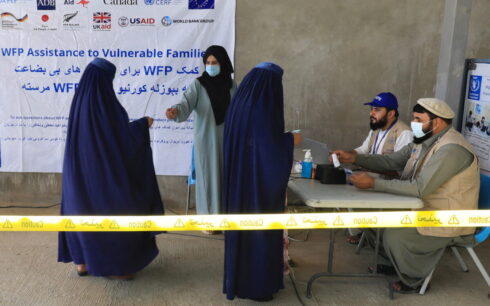The White House on Thursday sent a report to Congress on the chaotic withdrawal from Afghanistan in 2021 and blamed the chaos on a deal former President Donald Trump made with the Taliban a year earlier.
The document remains confidential but a summary of the review’s conclusions was released on Thursday night.
In a press conference on Thursday night, President Joe Biden’s national security spokesman, John Kirby, blamed the chaos on Trump’s Doha deal and said Biden had “acted in accordance with the best judgment of his advisers”.
Asked whether any officials involved with the withdrawal would be removed from their posts as a result of the report, Kirby said its purpose “is not accountability”.
“After-action reviews are a very common practice. They are not investigations. They are not criminal proceedings,” Kirby said. “The idea is to learn from them.”
The White House summary states that “President Trump ordered direct talks with the Taliban without consulting with
our allies and partners or allowing the Afghan government at the negotiating table. In September 2019, President Trump emboldened the Taliban by publicly considering inviting them to Camp David on the anniversary of 9/11.”
Listing other decisions taken by Trump, the summary states that as a result of Trump’s actions, the Taliban were in the strongest military position that they had been in since 2001, when Biden took office. With the Doha agreement in place, Biden faced the prospect of dealing with the resumption of attacks against US forces if he failed to withdraw the troops.
The summary stated: “Secretary of Defense [Lloyd] Austin testified on September 28, 2021, ‘the intelligence was clear that if we did not leave in accordance with that agreement, the Taliban would recommence attacks on our forces.”
On ‘planning for the withdrawal’, the summary stated that the departing Trump Administration had left the Biden Administration with a date for withdrawal, but no plan for executing it.
“And after four years of neglect – and in some cases deliberate degradation – crucial systems, offices, and agency functions that would be necessary for a safe and orderly departure were in disrepair.”
The summary states that in March, before Biden had made his final decision to withdraw, he directed his top national security officials, including the Secretary of State, the Secretary of Defense, the National Security Advisor, the Chairman of the Joint Chiefs of Staff, and the Director for National Intelligence, to begin withdrawal planning and account for a full range of
contingencies.
“Once the President made his final decision, national security teams accelerated the planning that was already underway,” the report read.
The White House maintained that as planning intensified throughout the late spring and early summer of 2021, intelligence reports continued to suggest that even if the Taliban made gains in some Afghan provinces the capital, Kabul, would be more difficult for the Taliban to take and the ANDSF would defend it.

The report claims that during this time, Biden urged the Ashraf Ghani government to take steps to harden the resolve of the Afghan forces, and press current and former Afghan officials to project a united front of support for the Afghan military forces.
However the security situation deteriorated and ultimately the Biden administration made a decision to reach out to Americans and Afghan partners about the risk of collapse. The review stated that tens of thousands of phone calls and messages to US citizens in particular were made telling them to leave Afghanistan but not to broadcast this publically.
“This calculus was made based on the prevailing intelligence and military view throughout the early weeks of August that Kabul would hold beyond the end of the withdrawal.”
But the collapse of the republic government “unfolded
more quickly than anticipated” – by anyone, including the Taliban and the republic government.
The report details the situation at Kabul airport during the evacuations and touches on the suicide bombing that left 170 Afghan nationals and 13 US soldiers dead. It also describes a US drone strike on a house in Kabul, that left 10 civilians dead.
In the report, the administration appears to shift any blame in the Aug. 26, 2021, suicide bombing at the airport, saying it was the U.S. military that made one possibly key decision.
“To manage the potential threat of a terrorist attack, the President repeatedly asked whether the military required additional support to carry out their mission at HKIA (airport),” the report said, adding, “senior military officials confirmed that they had sufficient resources and authorities to mitigate threats.”
In Thursday’s press briefing, Kirby credited US forces for their actions in running the largest airborne evacuation of noncombatants in history during the chaos of Kabul’s fall.

“They ended our nation’s longest war,” he told reporters. “That was never going to be an easy thing to do. And as the president himself has said, it was never going to be low grade or low risk or low cost.”
Pressed by reporters Thursday afternoon, Kirby repeatedly defended the U.S. response and effort to withdraw American citizens and argued with reporters who referred to the withdrawal as chaotic. At one point, he paused in what appeared to be an effort to gather his emotions.
“For all this talk of chaos, I just didn’t see it, not from my perch,” said Kirby, who was the Pentagon spokesman during the withdrawal.
“At one point during the evacuation, there was an aircraft taking off full of people, Americans and Afghans alike, every 48 minutes, and not one single mission was missed. So I’m sorry, I just won’t buy the whole argument of chaos,” he said.
Biden will not declassify portions of the report itself, Kirby said, citing the ongoing work of a bipartisan Afghanistan war commission and the sensitivity of the documents.
The release of the NSC review comes as the State Department and House Republicans battle over documents for classified cables related to the Afghanistan withdrawal. Last week, Mike McCaul, chairman of the House Foreign Affairs Committee, took an unprecedented step in subpoenaing Secretary of State Antony Blinken for a cable written by dozens of diplomats at the US Embassy in Kabul shortly before the withdrawal.
The July 2021 communication reportedly warned Blinken about the potential fall of Kabul via a special “dissent channel,” which allows State Department officials to issue warnings or express contrarian views directly to senior agency officials.





